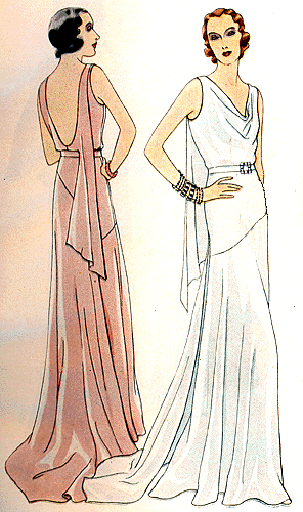
Oh No! What happened?! There was some real change in the fashion of the 1920's but now it seems to have gone back to the long dresses of before... But I guess you can't blame the people... The Great Depression hit them pretty hard. So let's look at the fashion of the 1930's...
Origins
Since many of the women were encouraged to stay home during the Great Depression (to allow for more jobs for men during this time) they were feminized and lost their boyish look that they gained during the 1920's. They returned to elegance and long dresses but this time the dresses didn't restrict movement (from what I can see). Though there was a lot of focus on the waistline but not as much as in the 1900's-1919's. The source below can explain in more detail...
Primary Source: Typically, when people think of Great Depression-era fashion, exciting thoughts do not necessarily spring to mind. Marking the end of Jazz Age decadence, the 1930’s are often thought of as a somber decade when it comes to fashion. However, to be honest, the 1930’s are one of my favorite eras of fashion (besides the 1960’s). Perhaps it is the existence of extreme opposites that interests me; the 1930’s saw both the bare minimum housedress of the typical woman simultaneously with the escapist Hollywood glamour of the pre-code silver screen. As a sort of apology for the frivolity of the flapper fashion, women’s dresses dropped their hemlines and were typically constructed of more practical, less ornate fabrics. The waistline assumed a more traditional, natural position. The ideal look, however, continued in the art deco fashion- streamlined, long, lean. Meanwhile, couture fashion pushed boundaries of the silhouette with the increased popularity of bias cut draping, as well as the influence of modern art movements, such as surrealism. Modern hardware, such as the zipper, was also popularized throughout the 1930’s. In a sense, the 1930’s is the start of the sort of classic period of vintage fashion that lasted up until the early 1960’s, a period marked by ultra-feminine silhouettes existing at a time when women’s roles in America were increasingly traditional, acting as the build up and inspiration for the second wave of feminism. The Great Depression insisted women stay home to allow for more chances for employment for men, a trend that would last until the factory boom of the 1940’s, only to re-emerge during the nuclear family-centric, suburban docility that was the 1950’s. Thus, women’s fashion was further feminized and defined, drifting away from the boyish, masculine silhouette of the flapper. With a few exceptions…
Purpose
This style wasn't necessarily "new" the waist line was more "natural" of course and the lower necklines are new but this style didn't cause the older generations to complain and there wasn't any problems with the style. The style could be seen as the fashion calming down from the extreme (for them... and a little for me I must admit (behavior wise)) of the style of the 1920's. The fashion style changed in the 1930's because there was a need to save money because of the Great Depression. So instead of buying new clothes every other month, they saved their clothes and made new ones with what they had.
2nd Primary Source: On October 24, 1929, Wall Street crashed and the Great Depression began. This would have a strong influence on women's fashion in the 1930s. Because of the need to save money, the average women could no longer buy new clothes every few months. Instead, they had to remake the clothes they already had, reusing any material that was on-hand. Only after clothes had been patched and mended beyond what was reasonable would they consider buying a new dress, or the fabric to sew a new one. Up until this time, the custom was for a person to change clothes a few times during the day, each time wearing the clothes appropriate for the activity, or for the time of day — a different set for morning, afternoon, and evening. Once the Depression took hold, this custom quickly began to be cast aside. Throughout the day, one would wear the same outfit, it would only be for certain occasions that one would change, such as donning evening wear when going out for the evening where more formal clothes would be warranted.

Value
The fashion of the1930's shows that the fashion in America died down. It shows this because in the 1920's many of the dresses were short and rebellious, but now the skirts were longer (but not restricting) the waist more shown (not without form like the square dresses of the 1920's) and a more emphasis on lady-like behavior.
Limitations
From the look of the fashion you can't really tell that the U.S. is going through a really bad economical crisis, but that's because we don't know how many different dresses the young women of this time had (the number of outfits was important to a girl in the 1920's but not so now...) We can't tell that the women are remaking their outfits when needed, but what we also can't tell is the struggling of many people who didn't have enough money to buy a new clothes or enough food for the family. We can't see the suffering of the lower class or the workers who work many, many, many hours for little pay.
No comments:
Post a Comment